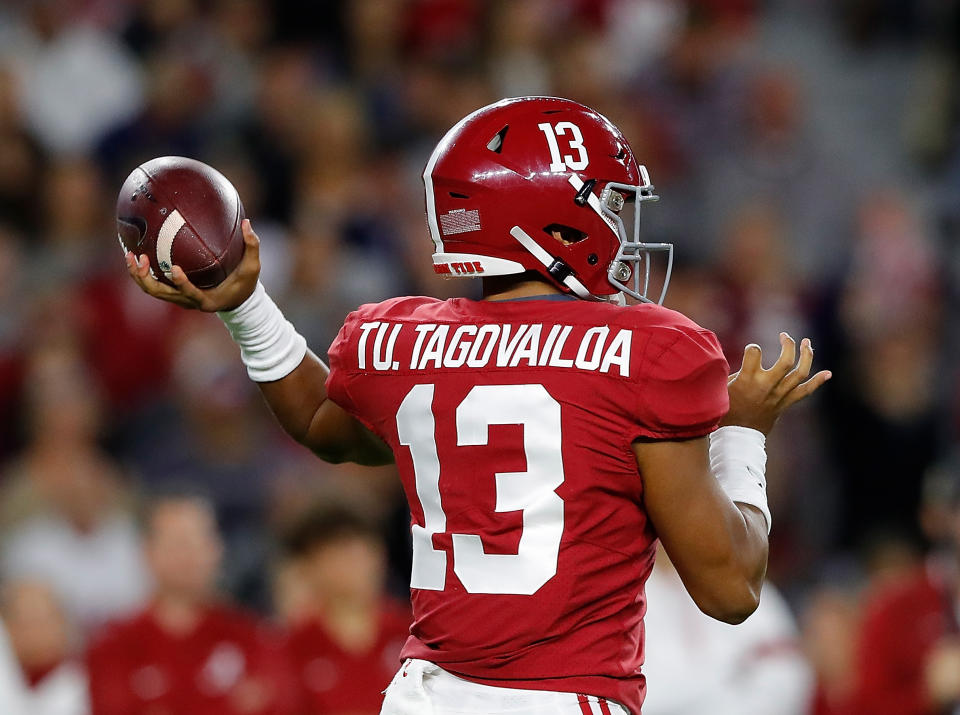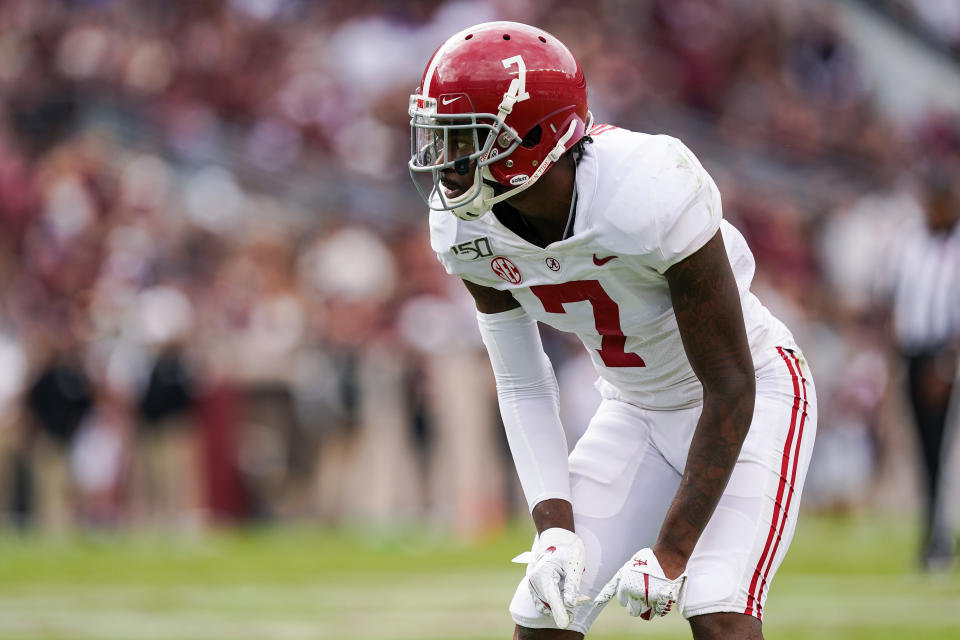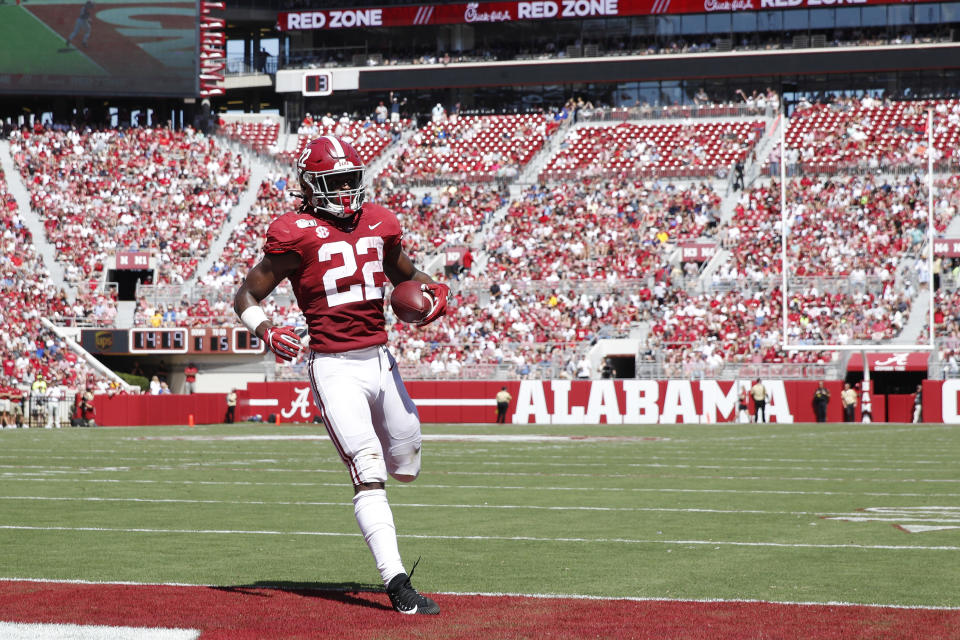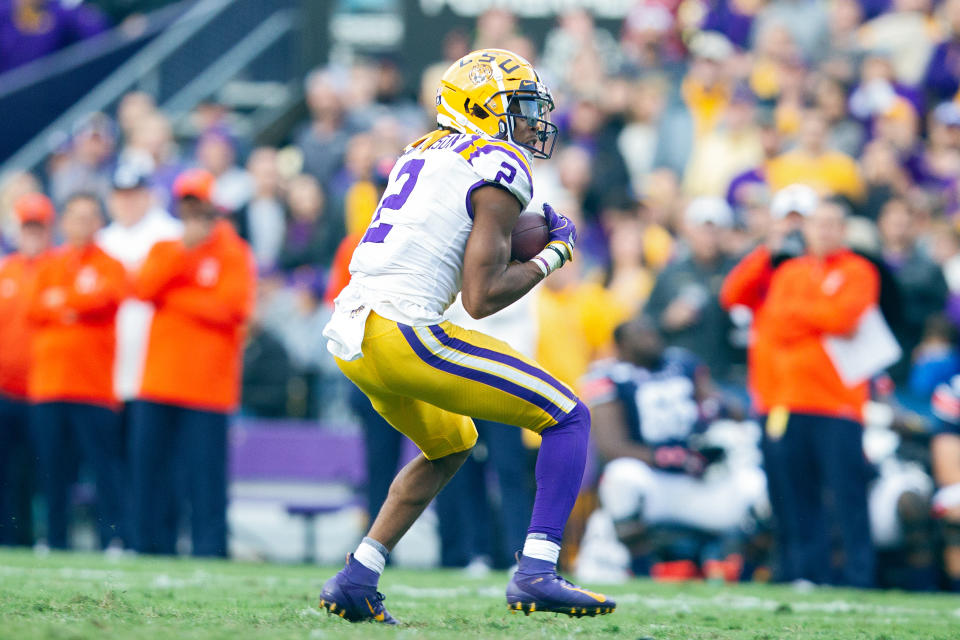LSU at Alabama: An NFL scout’s dream game, but also a nightmare
An NFL area scout this summer was thinking back to the first year he took over some of college football’s most fertile hunting grounds for talent — an exciting premise for a young evaluator but also a daunting one. That would be the Southeast region, which includes the SEC and, of course, one of the best programs in recent college football history.
“You arrive at Alabama the first time, it’s the mecca, really,” the scout said. “You get there, this great facility, all these rock-star coaches in the building — half of them are now head coaches at other schools. You see all these players in the building, and half of them are going to have a shot at [making] the league. Everyone wants in those doors.
“And then it dawns on you: ‘Oh God, I have to write all these guys up.’ It’s … a lot. Your first time, it can take you all night to get through them all.”
That’s the blessing and the curse of scouting Alabama, the program that has produced the second-most NFL draft picks since 2000 with 118, behind No. 1 Ohio State’s 133. Both schools are tied at the top of the list with the most first-round selections at 31 apiece.
In the past decade, those numbers have tilted more toward Alabama. The Crimson Tide have far outpaced the Buckeyes, with 83 overall picks to 62 and 28 first-rounders to OSU’s 15. Bama is first in both numbers since 2010.
And LSU, the team the Tide are hosting in Saturday’s big showdown, are tied with Ohio State for total draft picks since 2010 with 62, and it had 10 first-rounders in that span, including six who landed in the top 10.
Saturday’s game is massive for college football implications, sure. In the eyes of the NFL scouting community it also is the ganglion for football talent as it relates to the 2020 draft — not to mention future drafts.
“That press box will be packed,” texted one NFL general manager who said he plans on attending. He won’t be alone. If five NFL general managers can make it to Evanston, Illinois on a Friday night a few weeks ago to watch Ohio State’s two potential top-10 selections, imagine how many scouting heavyweights will be on hand at Bryant-Denny Stadium to see the talent LSU and Alabama will be fielding this weekend.
You want draft-related storylines? This one has it all.
It pits the possible first and second overall selections, in either order, of LSU QB Joe Burrow against Bama QB Tua Tagovailoa (health permitting).
There is Bama’s talented trio of wide receivers — Jerry Jeudy, Henry Ruggs III and DeVonta Smith — up against an LSU secondary whose five leading players all likely will be drafted, including potential 2020 first-rounders Grant Delpit and Kristian Fulton. (If true freshman CB Derek Stingley Jr. was draft eligible now, he might be the second defensive player drafted behind Ohio State’s Chase Young.)
The 2011 meeting between LSU and Alabama — aka the “Game of the Century” — produced a stunning 45 NFL draft picks, including 14 first-rounders, over the ensuing four drafts. It’s considered one of the great collections of future NFL talent on one college field in history, perhaps just behind the 2003 Fiesta Bowl between Ohio State and Miami.

All told, this year’s game could match that first-round total — in 2020 alone. Bama features a whopping 10 prospects who might end up in the first-round mix next year, with LSU having at least four players who have a shot to do the same.
It wouldn’t be stunning to see a conservative estimate of at least 25 players on the field Saturday who could be drafted in 2020, along with another half dozen or more who end up on NFL rosters next spring, depending on how many underclassmen from the two schools leave early.
By the time the 2023 NFL draft wraps up, the number of future NFL players in this game could approach 60 or more. That Ohio State-Miami game of yore produced 58 players who played at least one NFL game.
If you allow yourself a mere one college game for your 2020 NFL draft prep, this is probably the one to watch.
And amazingly, those numbers could have been higher had it not been for the torn ACL suffered by Alabama LB Dylan Moses, a top-10 prospect when healthy, and the recent dismissal of LSU LB Michael Divinity Jr., neither of whom will play in this one.
Here’s a rundown of the possible Day 1 and 2 selections (Rounds 1-3) in 2020 to monitor, plus a few other prospects who are just below that threshold, in Saturday’s contest:
Alabama
QB Tua Tagovailoa — The possible No. 1 overall selection, with the Cincinnati Bengals and Miami Dolphins perhaps the two most likely landing spots. The lefty is expected to play despite a recent ankle injury, and NFL scouts will want to see how he moves. An injury to his other ankle late last season hindered Tagovailoa in the SEC title game and the two playoff contests. Health concerns might be the most likely reason for Tagovailoa slipping out of the top spot in next year’s draft, but he appears to be the top-pick favorite now.
WR Jerry Jeudy — The 6-1, 193-pound Jeudy has been the focus of nearly every defense he has faced this season, which has resulted in reduced production: only three 100-yard games and a three-game span without a touchdown that ended with his two-TD game in his last time out against Arkansas. Still, NFL scouts love his skills, which should land him high up in Round 1. He wouldn’t be the first incredible WR talent from Tuscaloosa whose statistics pale in comparison to their NFL projection.
WR Henry Ruggs III — Though not as polished all around as Jeudy, Ruggs is perhaps the best big-play receiver in the country. He’s expected to at least threaten John Ross’ NFL scouting combine 40-yard dash record of 4.22 seconds and earns positive marks for his work ethic and football character. I rankled some folks last month when I said Ruggs could be drafted higher than Jeudy because of that elite speed. I stand by that assertion. Ruggs has been a bit quiet lately, but a big performance here vs. LSU’s talented corners could put him back in that discussion.

CB Trevon Diggs — The younger brother of Minnesota Vikings WR Stefon Diggs has everything desired in a No. 1 corner: size, ball skills, strength, speed, athletic bloodines and the Bama lineage as one of the best DB factories in college football. Trevon has raised his game this season after an up-and-down 2018 campaign, although he has been a spotty tackler at times. Still, he is a no-question first-round pick who could even crack the top 10. A big performance against LSU’s high-powered passing game would help that effort.
OT Alex Leatherwood — At right guard last season, the 6-foot-6, 315-pound Leatherwood was unremarkable, hardly displaying what he has so far in replacing 2019 first-rounder Jonah Williams at left tackle. Leatherwood might not be the technician Williams became at Bama but is a light-footed, long-armed, smooth operator who looks to be the next first-round Bama offensive lineman.
OT Jedrick Wills Jr. — Leatherwood’s bookend, Willis has graded out higher by Pro Football Focus with his 2019 play. Stylistically, Willis is far different, too: He’s a barroom brawler with brute strength yet also has nice balance to play in space. One scout who has been through Tuscaloosa said he would not be surprised to see the the 6-5, 320-pound Willis taken ahead of Leatherwood.
EDGE Terrell Lewis — Scouts have been tickled to see a healthy Lewis bounce back this season after missing all but four games the past two seasons because of arm and knee injuries. Fully healed, the 6-5, 255-pound Lewis has flashed first-round ability in collecting six sacks (tied for the SEC lead) and, per PFF, 23 QB pressures on only 283 defensive snaps — an absurd pass-rush win rate. LSU has allowed nearly two sacks per game this season, so Lewis could flourish Saturday. He’s a first-round talent, but the medical evaluation will carry a lot of weight in his final evaluation.
DL Raekwon Davis — The 6-7, 312-pound Davis certainly passes the eye test and possesses rare length and strength for the position, but he’ll be a tricky evaluation for NFL teams. Teams just don’t find his physical traits that often. But Davis might not be a pass rusher at the next level; after registering 8.5 sacks in 2017, Davis has had only 1.5 in his past 23 games — and zero this season. Some questioned Daron Payne similarly and he has done fine in the NFL. We could see Davis sneaking into the back end of Round 1 for the right team, but many scouts have Day 2 grades on him at this point.
S Xavier McKinney — Others are higher on McKinney than we are, but he certainly has versatility to cover the slot, blitz and tackle in the run game. McKinney has a nose for the ball and is a reliable back-end and box defender. Athletically, he’s nothing special, but McKinney will earn solid to good grades for his high floor as a prospect, pro readiness and good size (6-1, 202). A likely high Day 2 pick.
WR DeVonta Smith — Who currently leads Bama in receiving yards and touchdowns? No, not Jeudy, nor Ruggs, but Smith. The 6-1, 178-pound Smith possesses good but not elite speed and a very lean frame, but he has murdered the single coverage he has faced this season lining up amid the best group of college receivers (which also features 2021 draft prospect Jaylen Waddle). Scouts have dug on Smith’s character a bit, but he has improved his draft stock with his play to where he could be a top-75 selection. One Southeast area scout we spoke with even said he thought Smith might have the best hands at Alabama, which is saying something. In case you forgot — Bama and Georgia fans certainly haven’t — Smith caught the game-winning touchdown from Tagovailoa in overtime of the 2017 national title game.
S Shyheim Carter — Carter is one of a few Bama players who grew up in Louisiana, about an hour down the road from LSU’s campus. The 6-foot, 191-pound do-it-all defender has lined up as a deep safety, box safety and slot corner — his primary spot, which means he could see a lot of Jefferson on Saturday. That’s a tough matchup, and you can bet Carter will get over-the-top help. His vertical speed and downfield coverage ability are concerns, but Carter is a tough, active, sound-tackling defender who could make a solid pro eventually. Style-wise, he’s kind of a poor man’s Minkah Fitzpatrick, minus the top-end measurables and athleticism.

RB Najee Harris — Scouts wanted to see Harris become more involved in the pass game this season, and he’s done that. The 6-1, 230-pound back had only 10 receptions for 52 yards and no TDs (in 25 games) coming into the season, but Harris has hauled in 16 passes for 171 yards and four TDs, even making highlight-reel runs after a few of those grabs. Still, he’s a power-first back, and even with Harris’ ability to pinball through would-be tacklers, we’re not enamored with his vision or short-area quickness. He’s more of a build-up runner who needs lanes created for him. There’s a likely spot for him on Day 2 of the draft if he tests fairly well.
EDGE Anfernee Jennings — He took a step back in 2018 following offseason knee injury and didn’t show the pass-rush burst he has previously. But Jennings has been on the progression track in 2019, posting some standout performances (check out his South Carolina, Ole Miss and Tennessee games) mixed in with a few duds. His consistency is a question, along with his limitations in coverage, tackling ability in space and somewhat undisciplined play (eight penalties this season). Still, he’s a long-armed rusher who can disrupt passing lanes and might be a better pro than college player.
LSU
QB Joe Burrow — Building off his final four games of last season, Burrow has been one of the true breakout players in college football over the past 12 months. He’s extraordinarily confident, has terrific pocket poise, can make just about every throw and will grade out as a plus athlete for the position. There’s something about him that screams … swagger. Fair or not, our evaluation of him is likely to change after this game, his biggest test to date. If Burrow dices up Bama, he could overtake Tagovailoa as the top QB. If he struggles, Burrow could drop.
S Grant Delpit — His tackling woes early in the season have subsided, which has caused us to drop his grade from the top-10 range we had coming into the season. That said, there are only so many nearly 6-foot-3, 203-pound safeties who have his pass-game recognition, ball skills, CB-like athleticism and closing quickness. Delpit is also a quality blitzer, is tough and projects to be a back-half chess piece in the NFL, but opponents have found ways to exploit him. Delpit is too rare to get out of the top 20, perhaps even approaching the first 10 selections.
CB Kristian Fulton — The LSU coaches believe that prior to his knee injury last year, Fulton was playing better than Cleveland Browns second-rounder Greedy Williams, who mostly slipped out of Round 1 because of character concerns. The 6-foot, 200-pound Fulton hasn’t quite reached that peak 2018 mark this season, but he’s been pretty darned good — perhaps overshadowed unfairly by true-frosh phenom Derek Stingley. Fulton has been a bit handsy and prone to giving up plays downfield, such as in the Texas and Utah State games. But we see a future NFL starter with good size, athleticism and enough instincts and playmaking ability to solidly land in Round 1. He likely will earn a higher grade from me than last year’s top corner drafted, Georgia’s Deandre Baker, who went 30th to the New York Giants.
EDGE K’Lavon Chaisson — We placed Chaisson on a list of possible dark-horse first-round selections back in July, and he mostly has flashed his rare athleticism this season, even while shaking off the rust from a torn ACL early in the 2018 season and a lower-body injury (undisclosed, but he was seen in a walking boot) that cost him a few games this year. The 6-4, 250-pound rusher has freakish upside and could be a Jamie Collins-like player in time, able to drop, rush, defend the run and deliver big plays. Even with the durability concerns, strong postseason testing could make him the fourth Tiger to land in Round 1. And yes, Chaisson is a junior, but there has been significant buzz about him declaring early.

WR Justin Jefferson — With Burrow’s rise, Jefferson has emerged as his go-to target and will be a key figure in the Bama game. Facing as talented a secondary as you’ll see in the country outside of Ohio State, Jefferson can kick his ascending draft stock into high gear. The acrobatic 6-foot-3, 192-pound receiver doesn’t have blazing speed but is great with the ball in the air, attacking 50-50 passes with gusto, and also finding soft spots vs. zone coverage. He looks like a higher-end WR2 in the NFL and appears poised to test the draft waters in January. Jefferson hasn’t dropped a pass since the season opener, but his separation ability could be a concern for evaluators.
DT Rashard Lawrence — Hindered by an ankle injury, Lawrence’s pressure production has dropped off significantly from last season. Still, he can play multiple spots on the line and should fit most schemes, able to mix in a nice array of interior pass-rush moves with respectable closing quickness. You just wonder if he’ll ever be special, but a spot in the top 100 picks should be achievable.
OG Damien Lewis — At 6-3 and 332 pounds, Lewis — nicknamed “The Man Child” — has the build of a road-grading guard in a power scheme. The junior-college transfer considered coming out for the 2019 NFL draft, and while he has cleaned up some of the mental mistakes he made last season, Lewis hasn’t been as effective this season as a pass or run blocker. We see him as a possible late Day 2 or early Day 3 prospect.
LB Patrick Queen — We don’t know what the junior’s plans are for the 2020 NFL draft, but he’s an active athlete with blitz potential and good range in coverage. The LSU game we attended this season against Utah State, Queen was all over the field. He has been good, not great, for the remainder of the season and likely could help his stock by waiting a year and becoming one of the leaders of the Tigers’ 2020 defense. There’s an intriguing prospect lurking in the 6-1, 227-pound Queen.
RB Clyde Edwards-Helaire — He’s coming off one of his better games of the season vs. Auburn, rushing for 136 yards against a good defense in the narrow victory. A lot of comparisons have been made between the 5-foot-8, 209-pound Edwards-Helaire and former Tigers back Stevan Ridley — both compact backs with good power and underrated shiftiness. Edwards-Helaire has been hurt by LSU’s new spread attack, but he’s maximized his chances when asked to deliver. He might not be special in too many ways, but there’s plenty of tread left on his tires — and he could be a surprise feature back in this game, depending on how Nick Saban defends Burrow and the pass game. He also is a quality kick returner who could make a difference on special teams in this one. We hear Edwards-Helaire will consider declaring early with five-star RB John Emery waiting in the wings.
S JaCoby Stevens — Like Delpit, Stevens can make plays near the line of scrimmage almost like a hybrid linebacker and also play back deep in coverage. He hasn’t been as impactful as Delpit the past two seasons, but the 6-1, 228-pound Stevens has transitioned nicely since starting out at LSU as a receiver. There’s some untapped ability that could flourish in the NFL, and Stevens will earn high marks for character. He’s a favorite of the coaching staff for his willingness to fill whatever role they ask of him.
CB Kary Vincent — The nickel back for the Tigers, Vincent has been on the field for the majority of the team’s defensive snaps. He isn’t a top-100 pick because of his size limitations (5-10, 185), limited playmaking ability and a few lapses in coverage. But Vincent is good enough to dent an NFL roster and play inside with his quickness and instincts.
C Lloyd Cushenberry — Whenever he declares, Cushenberry projects to being a strong run blocker who surprisingly has taken a step back in pass protection as the Tigers have shifted to more of a spread attack.
LS Blake Ferguson — He’s not going in the top 100 picks, but it’s notable that Ferguson might be a draft prospect, which is rare for the position. He could be a 10-year snapper in the league. Scouts love his consistency and intangibles and think he could end up as the best long snapper in the NFL.
More from Yahoo Sports:
